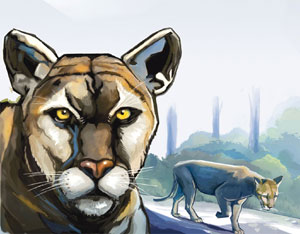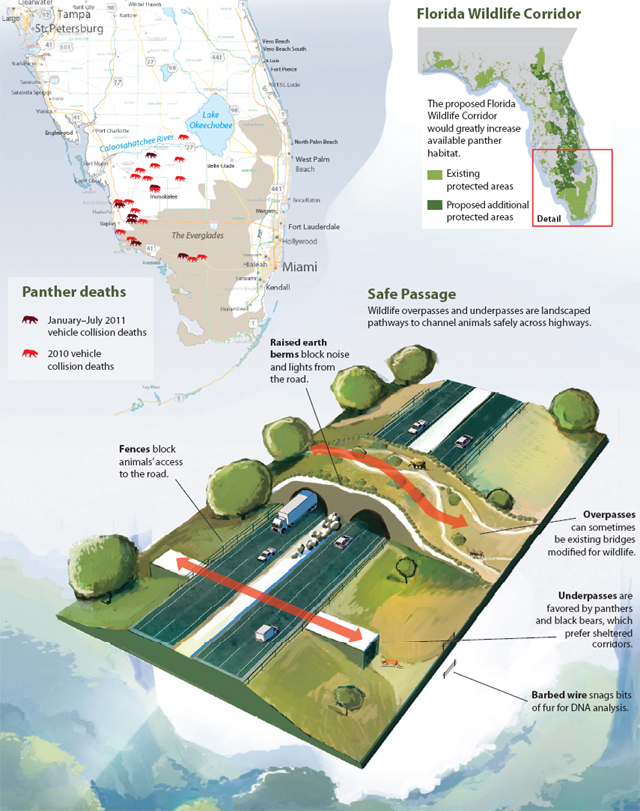sierraclub.org - sierra magazine - sept/oct 2011 - panther at the crossroads
Without room to roam, Florida's big cats are roadkill waiting to happen
By Tristram Korten | Illustration and map by Javier Zarracina
 On the afternoon of July 11, yet another Florida panther was discovered lying on a lonely stretch of Immokalee Road, an east-west corridor that cuts through cattle and farm country in rural Florida. The year-old male was the 7th big cat killed by a vehicle this year and the 19th killed overall, a rate that is set to outpace the 23 deaths in 2010 and 25 in 2009.
On the afternoon of July 11, yet another Florida panther was discovered lying on a lonely stretch of Immokalee Road, an east-west corridor that cuts through cattle and farm country in rural Florida. The year-old male was the 7th big cat killed by a vehicle this year and the 19th killed overall, a rate that is set to outpace the 23 deaths in 2010 and 25 in 2009.
That late-night collision continued another unsettling trend. For the past decade, cars have been the leading cause of known panther deaths, surpassing panther-on-panther aggression. The increasing human traffic within panther territory is taking its toll.
Only weeks before the accident, the U.S. Fish and Wildlife Service had declared the Eastern cougar—which hadn't been seen in decades—extinct. That leaves the Florida panther, itself on the threshold of extinction, as the eastern seaboard's sole surviving big cat.

Only 100 to 160 adult Florida panthers live in the wild today, according to government estimates. Roughly 20 percent of that population is killed off annually—a number barely replenished by yearly litters.
Puma concolor coryi once prowled the Southeast as far west as Missouri. But the growth of subdivisions curtailed the big cat's range to South Florida's sodden hinterlands. Female panthers roam territories as large as 75 square miles; males, up to 200 square miles. They need that space, especially the fiercely territorial males, which regularly kill trespassing competitors. As panther range shrank, so did their numbers, dipping down to the 30s in the 1980s before protection efforts ramped up. That's when the Texas cougar, a genetic cousin, was introduced to Florida to diversify the DNA and avoid inbreeding.
Constructing animal-friendly over- and underpasses so panthers can safely cross roads is one way to prevent them from being hit by cars. Another is to identify and protect land adjacent to existing reserves and ranches to create a contiguous habitat stretching the length of the Florida peninsula, a mission of the Florida Wildlife Corridor initiative. A key benefit is that it would allow female panthers to range north of the Caloosahatchee River, currently a natural barrier, by going around Lake Okeechobee. (Males are able to cross the river, and one has even been sighted in Georgia.)
The Sierra Club has sued the federal government to get it to designate 3 million acres as critical habitat for the panther. This would broaden the government's power to control development in those areas. A judge dismissed the lawsuit on jurisdictional grounds earlier this year, but Club lawyers are appealing.
Environmental groups in Florida are divided on the question of new development in panther territory. Some are seeking compromise, agreeing to accept some construction in exchange for new protected areas. The Sierra Club, on the other hand, opposes all new development where cats roam. "If you bring new people and cars into panther habitat, you'll kill panthers," says Frank Jackalone, the Sierra Club's senior organizing manager for Florida. "It's as simple as that."
TRISTRAM KORTEN is a journalist who lives in Miami.
This article was funded by the Sierra Club's Resilient Habitats Program.